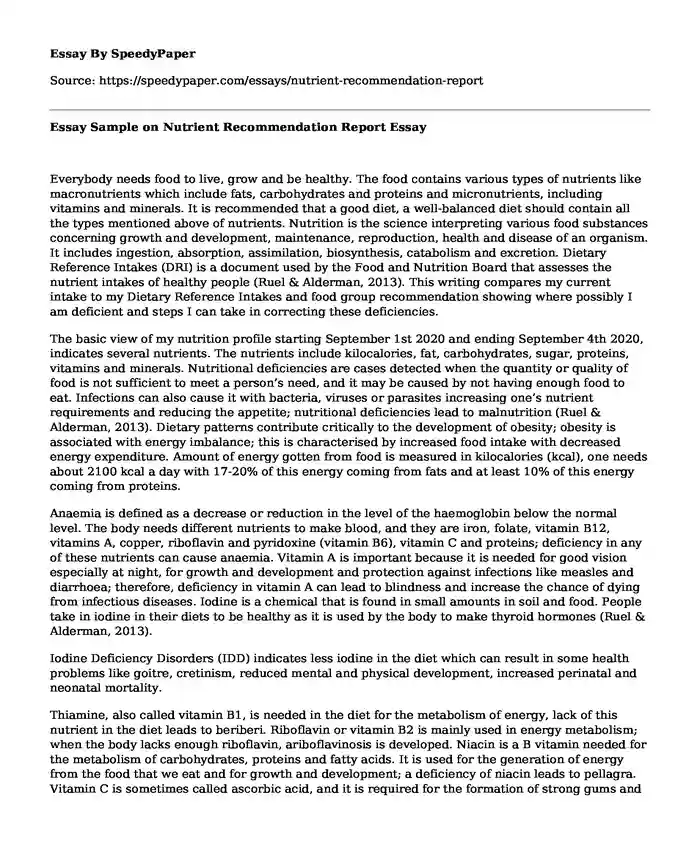
| Essay type: | Narrative essays |
| Categories: | Food Healthcare Nutrition Personal experience |
| Pages: | 3 |
| Wordcount: | 765 words |
Everybody needs food to live, grow and be healthy. The food contains various types of nutrients like macronutrients which include fats, carbohydrates and proteins and micronutrients, including vitamins and minerals. It is recommended that a good diet, a well-balanced diet should contain all the types mentioned above of nutrients. Nutrition is the science interpreting various food substances concerning growth and development, maintenance, reproduction, health and disease of an organism. It includes ingestion, absorption, assimilation, biosynthesis, catabolism and excretion. Dietary Reference Intakes (DRI) is a document used by the Food and Nutrition Board that assesses the nutrient intakes of healthy people (Ruel & Alderman, 2013). This writing compares my current intake to my Dietary Reference Intakes and food group recommendation showing where possibly I am deficient and steps I can take in correcting these deficiencies.
The basic view of my nutrition profile starting September 1st 2020 and ending September 4th 2020, indicates several nutrients. The nutrients include kilocalories, fat, carbohydrates, sugar, proteins, vitamins and minerals. Nutritional deficiencies are cases detected when the quantity or quality of food is not sufficient to meet a person’s need, and it may be caused by not having enough food to eat. Infections can also cause it with bacteria, viruses or parasites increasing one’s nutrient requirements and reducing the appetite; nutritional deficiencies lead to malnutrition (Ruel & Alderman, 2013). Dietary patterns contribute critically to the development of obesity; obesity is associated with energy imbalance; this is characterised by increased food intake with decreased energy expenditure. Amount of energy gotten from food is measured in kilocalories (kcal), one needs about 2100 kcal a day with 17-20% of this energy coming from fats and at least 10% of this energy coming from proteins.
Anaemia is defined as a decrease or reduction in the level of the haemoglobin below the normal level. The body needs different nutrients to make blood, and they are iron, folate, vitamin B12, vitamins A, copper, riboflavin and pyridoxine (vitamin B6), vitamin C and proteins; deficiency in any of these nutrients can cause anaemia. Vitamin A is important because it is needed for good vision especially at night, for growth and development and protection against infections like measles and diarrhoea; therefore, deficiency in vitamin A can lead to blindness and increase the chance of dying from infectious diseases. Iodine is a chemical that is found in small amounts in soil and food. People take in iodine in their diets to be healthy as it is used by the body to make thyroid hormones (Ruel & Alderman, 2013).
Iodine Deficiency Disorders (IDD) indicates less iodine in the diet which can result in some health problems like goitre, cretinism, reduced mental and physical development, increased perinatal and neonatal mortality.
Thiamine, also called vitamin B1, is needed in the diet for the metabolism of energy, lack of this nutrient in the diet leads to beriberi. Riboflavin or vitamin B2 is mainly used in energy metabolism; when the body lacks enough riboflavin, ariboflavinosis is developed. Niacin is a B vitamin needed for the metabolism of carbohydrates, proteins and fatty acids. It is used for the generation of energy from the food that we eat and for growth and development; a deficiency of niacin leads to pellagra. Vitamin C is sometimes called ascorbic acid, and it is required for the formation of strong gums and skin, for normal growth of bones and blood capillaries and absorption of iron; when the body lacks this nutrient, it develops scurvy. Vitamin D is used for the growth of bones; it is naturally made in the skin when people exposed to sunlight (Ruel & Alderman, 2013). Vitamin D from the diet is also important, especially when there is not enough sunlight. When children lack vitamin D, they develop rickets while in women, vitamin D deficiency contributes to another disease of the bone called osteomalacia.
In conclusion, taking nutrients in their required quality and quantity is very important as it strengthens the body immune system, therefore, reducing chances of contacting nutrient deficiency problems and other diseases. Creating awareness through health education about the consumption of a well-balanced diet and food procession is important as it ensures the best use of the available food (Ruel & Alderman, 2013). People should understand the importance of different nutrients, which foods contains them and how to prepare the foods to preserve, as long as possible, the nutritional value.
Reference
Ruel, M. T., Alderman, H., & Maternal and Child Nutrition Study Group. (2013). Nutrition-sensitive interventions and programmes: how can they help to accelerate progress in improving maternal and child nutrition?. The lancet, 382(9891), 536-551.
https://doi.org/10.1016/S0140-6736(13)60843-0
Cite this page
Essay Sample on Nutrient Recommendation Report. (2023, Nov 27). Retrieved from https://speedypaper.com/essays/nutrient-recommendation-report
Request Removal
If you are the original author of this essay and no longer wish to have it published on the SpeedyPaper website, please click below to request its removal:
- Research Paper Sample on Physician Stressors During Patient Care
- Essay Sample on Motherhood Infertility
- Free Essay Example - Flynn Effect
- What Action Should Dr. Seldom Have Taken? Essay Sample
- Free Essay: Summary of the Health Care Problem
- Dual Roles of Medics in Contemporary Healthcare: Balancing Professional and Management Responsibilities
- Optimizing Hip Replacement in Elderly Patients: Exploring Lateral Positions for Enhanced Mobility
Popular categories




